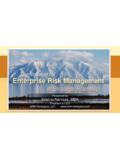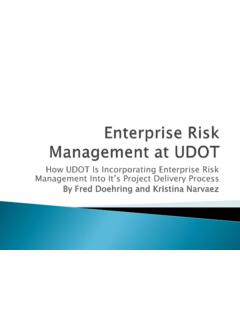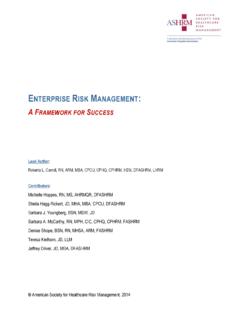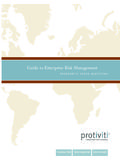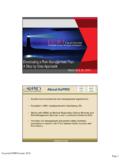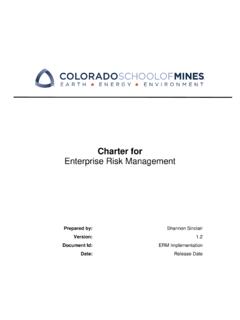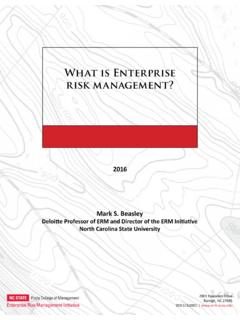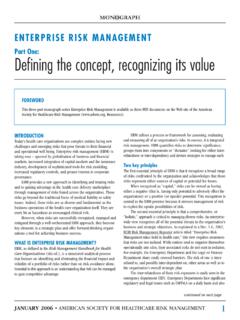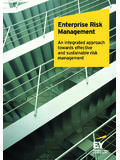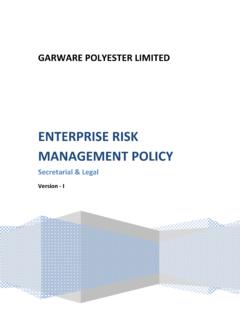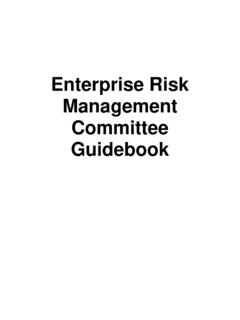Transcription of Enterprise Risk Management - ERM Strategies
1 Enterprise Risk Management ERM provides a framework for risk Management , which typically involves identifying particular events or circumstances relevant to the organization's objectives ( risks and opportunities), assessing them in terms of likelihood and magnitude of impact, determining a response strategy, and monitoring progress. By identifying and proactively addressing risks and opportunities, business enterprises protect and creates value for their stakeholders, including owners, employees, customers, regulators, and society overall. Risk Identification Risk Assessment Risk Analysis Implementation Monitoring Evaluation ERM Framework Difference Between GRC & ERM Enterprise Risk Management (ERM) Is concerned with delivering measurable business value by tying front line operational activities to goals across all business units.
2 Governance Risk and Compliance (GRC) Embraces compliance as a separate activity for each business silo. Burden of Compliance Suppresses Risk Taking Activities Many organizations believe that they must continue to eliminate risk through compliance Risk has not been eradicated by regulation instead it has been driven underground Risk taking activities are not bad if an organization has established their risk appetite and risk tolerance levels and has the proper risk controls in place Risk Appetite and Risk Tolerance Risk Appetite is the manner in which an organization and its stakeholders collectively perceive, assess and treat risk Risk Tolerance requires a company to consider in quantitative terms exactly how much of its capital its is prepared to put at risk ERM Is Used for Risk Optimization Considering both the upside and downside outcomes of risk taking activities When threats and opportunities are better understood, risk taking is optimized and managers, in turn, will make more informed business decisions Improved decision making enables an organization to quickly meet emerging marketplace challenges Six Step Approach to ERM 1 Risk Identification 2 Risk Assessment 3 Risk Analysis 4 Implementation 5 Monitoring 6 Evaluation 1.
3 Risk Identification The process of taking inventory of all risks in an organization and defining the potential risk event, the causes to that risk event, and the potential outcome if that risk event were to occur Focus not only on hazard or operational risks , but also strategic, financial, reputational, compliance, environmental, human capital and technology, market, and supply chain risks Scope of Risk Identification Define where the source of a potential risk event is coming from; Inside or Outside the organization. Establishing risk categories helps to identify the sources of a risk event. Strategic Operational Financial Other Risk Categories Strategic Risk Categories Strategic risks Innovation Risk Customer Risk Market Risk Investor Risk Brand Risk Planning Risk Partnering Risk Supply Chain Risk R&D Risk Operational Risk Categories Operational Risk Human Capital Risk Communication Risk Sustainability Risk Regulatory and Legal Risk Governance Risk Financial Reporting Risk Fraud Risk Emerging Risk Technology Risk Hazard Risk Financial Risk Categories Financial risks Financial Market Risk Credit Risk Liquidity Risk Interest Risk Asset Risk Foreign Investment Risk Inflation Risk Hedging Risk Valuation Risk Other Risk Categories Other Reputational Risk Environmental Risk Third Party Risk Economic Risk Project Risk Investment Risk Identify Subcategories Hazard Risk
4 Safety risk of increased slips, trips and falls accidents occurring in the organization Operational Risk Human capital risk of 25% of workforce is eligible for retirement in the next 5 years Financial Risk Credit risk of 35% of commercial loans will default in the third quarter Strategic Risk Sole supplier of a raw material has been acquired by competitor Existing & Emerging Risk Look not only at existing risks , but also the emerging risks to the organization. What new business processes have been added to the organization? What changes have been made in the organizational chart? What are some external risks that could impact the organization like economic, environmental, societal, geopolitical, and technological? Know Where You Stand Meet with senior Management to define the strategic goals of your organization Review the mission and vision statements of the organization Define the expectations of internal and external stakeholders Don t Be Conflicted This conflict caused the quality control of manufacturing to suffer.
5 Case in point the Cidra Plant in Puerto Rico made 20 drugs under unhealthy conditions that lead to a $750 million FDA fine GlaxoSmithKline A study in conflicting strategic goals One of GSK s strategic goals was to sell safe and effective prescription medication Another goal was to increase profitability by outsourcing manufacturing to other parts of the world Next Steps Identify the risk Management objectives to support the strategic goals of the organization Review the Risk Policy of the organization Create a SWOT Analysis (Strengths, Weaknesses, Opportunities, and Threats) reviewing the internal and external content of the organization SWOT Analysis Risk Identification Activities Brainstorming Can effectively generate lots of ideas of potential risk scenarios that could take place Structured Interviews Uses a risk survey or questionnaire to ask specific questions related to different types of potential risk events facing a particular risk owner or risk center Top Down / Bottom Up Approach Establish Risk Criteria External and internal parameters for managing risk in an organization Responsibilities of risk owner Risk centers assigned to risk owner Determine critical risks in the organization.
6 Prioritize the critical risks from greatest to least UC s ERM Work plan University of California has developed an ERM Work plan for its employees. Within the context of campus/medical center s mission, the Management team establishes strategic goals, selects strategy and aligns ERM objectives to the strategic plan . The Enterprise risk Management framework is geared to achieving objectives in four categories: Strategic High-level goals, aligned with and supporting their mission Operations Effective and efficient use of their resources Reporting Reliability of reporting Compliance Compliance with applicable laws and regulations Key Performance Indicators (KPI) % of customer attrition % of employee turnover Rejection rate Meantime to repair IT problems Customer order waiting time Profitability of customers by demographic segments Key Risk Indicators (KRIs) KRIs are leading indicators of risk to business performance.
7 They give us an early warning to identify a potential event that may harm continuity of the activity/project. % of suppliers with no business continuity Management % of mission-critical recovery plans not exercised with the last 12 months % turnover of mission-critical IT personnel % of mission critical business processes with a backup/recovery architecture Supply Chain Disruption Some sources of risk are not directly under the control of the organization, but are a part of their supply chain. March 11, 2011 - A massive tsunami devastated the coastline of Japan. GM, who might had a competitive advantage to their Japanese competitors, had a transmission that was manufactured in Japan for its Chevy Volt Cascading Effects Business is interrupted Loss of employees Quality and productivity goes down Competitor takes market share due to business interruption Tools and Techniques Tools and Techniques Questionnaire & Risk Survey Loss Histories Financial Statements Flowcharts Personal Inspections Interview Subject Matter Experts Conduct HAZOP and what if scenarios Define business or process drivers of the organization Review what is said about your organization on social media networks Create A Risk Register Create A Risk Register Identify a potential risk event Categorize the risk event Identify potential causes Assign risk owner Determine the likelihood Determine the consequences What is the financial impact
8 Risk treatment Date to review risk Sample Risk Register Sample Risk Heat Map Risk Tornado Diagram 2. Risk Assessment Risk Assessment is a process to determine the cause of the risk event, the risk event itself, and the impact and the velocity of the risk event. Root Cause Analysis- Find the root cause of a potential risk event Qualitative Assessment-Recognizes the source of the risk event Quantitative Assessment-Measures the value of the impact 2 Risk Assessment Causes of Risk Three Basic Causes Physical causes A tangible or material item failed in some way. Brakes stop working on a car Human causes People did something wrong or did not do something required. No one check the condition of the brakes Organization causes A system, process or policy that people use to make decisions in doing their work is faulty.
9 No procedure for checking the maintenance of the cars 2 Risk Assessment Root Cause Analysis Methods The 5-Whys Barrier Analysis Change Analysis Parent Analysis Casual Factor Tree Analysis Fish-Bone Diagram or Ishikawa Diagram Failure Mode Effect Analysis Fault Tree Analysis Management Oversight and Risk Tree 2 Risk Assessment Fault Tree Analysis Very useful in examining the possible conditions that may lead to a desired or undesired event Top event will be placed at the top of the tree and all subsequent events that lead to the main event will be placed as branches Symbols provide a pictorial representation of the event and how it interacts with other events on the tree 2 Risk Assessment Example Fault Tree 2 Risk Assessment Qualitative Analysis Positive Fault Tree Analysis Will identify the events necessary to achieve a top desired event for example no accident in manufacturing facility Negative Fault Tree Analysis Constructed to show those events or conditions that will lead to a top undesired risk event such as a fire in the manufacturing facility 2 Risk Assessment Quantitative Analysis When the likelihood of an event is know and a probability value has be assigned, then analysis of these events on a fault tree will also yield quantitative results.
10 Financial impact can be added to each stage of the Fault Tree Analysis. Risk correlation can be demonstrated. 2 Risk Assessment State of Washington s Nine Step Approach to Root Cause Analysis Verify the incident and define the problem Map a timeline of events Identify critical events Analyze the critical event s cause and impact Identify root causes Support each root cause with evidence Identify and select the best solutions Develop recommendations Track implementation of solutions 2 Risk Assessment 3. Risk Analysis Understand Risk aggregation and risk correlation in an organization s risk portfolio Determine The interrelationship of risk exposures to a potential risk event Formulate The best risk Strategies for the organization from risk assessments 3 Risk Analysis Department of Homeland Security DHS plays a leadership role in the Nation s unified effort to manage risk working across the homeland security Enterprise which includes Federal, state, local, tribal, territorial, non-governmental and private sector entities.
